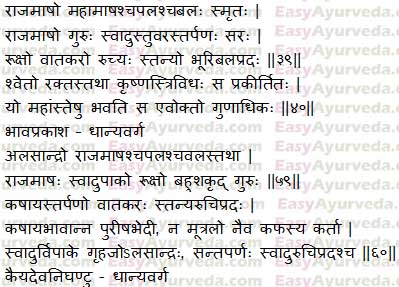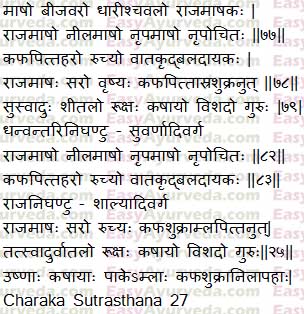Cowpea – Vigna unguiculata (Lobia) – Qualities, Benefits, Research
By Dr Renita D’Souza
Cowpea (Vigna unguiculata) are nutritious and delicious legume crop. It is high source of protein and often known as ‘poor mans meat’. In Ayurveda the cowpeas are known as Rajamasha.
Due to its astringent taste it is neither purgative nor diuretic and it will not aggravate Kapha dosha. Cowpeas are diuretic, maintains gastro intestinal functions, Vermicidal and good nutritive legume.
Read – Ayurveda Mahodadhi: Legumes Green Gram, Chickpea, Peas
As per the reference found in Kshemakutuhalam, cowpea is cardiac tonic and balances kapha and pitta dosha. It causes bloating and is absorbent (grahi) in nature.
Botanical Name – Vigna unguiculata
Family – Leguminosae
Table of Contents
Vernacular names
Names in different Languages
English Name – Cowpea, Chinese Beans, Black-eyed peas
Hindi Name – Rajamasha, Boda, Choura, Lobiya, Lobia
Bengali Name – Barbati kalaya, Barbati
Marathi Name – Alansande, Chavli
Kannada Name – Alasande
Telugu Name – Alasandalu
Tamil Name – Karamani
Chinese Name – Long bean, Asparagus bean
Benefits, remedies
Benefits of Cowpeas
Maintains Cholesterol Level – Cowpeas are the good source of soluble fiber and protein which maintains the bad cholesterol in the blood.
Anti cancerous – Cowpeas are antioxidant agent and can be used to stop the growth of cancerous cell.
Anti diabetic – They maintain the blood sugar level and prevent diabetes.
Cardiac tonic – Including cowpeas in diet will reduce the risk of cardiac disease due to its flavonoids content.
Maintains Gastrointestinal health – It improves the digestion, taste, increases the intestinal mobility and bulk of feces. Thus helps to maintain digestion and eases the bowel movements.
Maintains the Normal weight – It is nourishing and does not increase fat. It is a cholesterol free bean.
Skin health – It rejuvenates the skin cells and removes ageing symptoms like wrinkles, black spots, dark circles etc
Hair health – It facilitates hair growth, prevent hair fall and makes hair smooth and shiny. (A)
Cowpeas as unwholesome diet
Sciatica
Vata disorders
Medicinal Qualities
Medicinal Qualities of Lobia
Taste – Sweet, Astringent
Vipaka (taste conversion after digestion) – sweet
Guru – heavy in nature
Virya (potency) – shita (cold)
Vishada – non-slimy and helps to bring about clarity to the body channels
Tarpanah – nourishing
Sara – increases intestinal mobility
Ruksha – dry in nature
Ruchya – improves taste
Sthanya – improves breast milk
Bhuribalaprada – best strength promoter
Bahushakrth – increases stool bulk
Vrishya – aphrodisiac
Kapha pitta asra shukranuth – decreases kapha, pitta, blood tissue and sperm
Read – Barley (Hordeum vulgare) – Qualities, Uses, Remedies, Research
Lobiya – Effect on Tridoshas
Vatakara – increases vata dosha
Read – Daal – Soup Of Pulses – Preparation Method, Health Benefits
Sanskrit verse


Interaction with medicines, supplements
Can this be used while taking Homeopathic medicine?
Yes. This product does not react with homeopathic medicine.
Can
this medicine be continued while taking supplements like multivitamin tablets,
Omega 3 fatty acids etc?
Yes. Generally, this product goes well with most
of the dietary supplements. However, if you are taking more than one product
per day, please consult your doctor for an opinion.
With western
medicines
Seek your
doctor’s advice if you are taking this product along with other western
(allopathic / modern) medicines. Some Ayurvedic herbs can interact with modern
medicine.
If both Ayurvedic and allopathic medicines are advised together, then it is
best to take Allopathic medicine first, wait for 30 minutes and then take the
Ayurvedic medicine.
Types of Lobia, nutritional value
Varieties of Cowpeas
White
Red
Black
Nutritional Value of Cowpeas
Cowpeas contain Vitamin A, B1, B2, B3, B5, B6, C, folic acid, iron, potassium, magnesium, calcium, selenium, sodium, zinc, copper, phosphorus, etc.
Read – Green Gram (Mung bean) Qualities, Uses, Remedies, Research
Morphology, distribution, research
Morphology of Cowpeas
Vigna unguiculata is an annual herbaceous legume. Leaves are dark green, less pubescent. Color of flower varies from yellow, pink, white, purple and blue. Peduncles 20–50 cm are long, hold the flowers and seed pods. Size of pod can vary from 10-100 cm long. Seeds are kidney shaped.
Distribution
Cowpea is native to Central Africa. It is cultivated in Africa, Asia, North and South America
Research
Anti-hyperlipidemic – A research study was conducted to find in adults with moderate hypercholesterolemia that whether intake of cow-pea protein improves lipid profile and bio-markers of inflammation and endothelial dysfunction. The result showed that cowpea protein significantly reduced total cholesterol ( 12 %), LDL cholesterol ( 18.9 %), non HDL-cholesterol ( 16 %) and apoB ( 14 %), and increased HDL cholesterol (+2.7 %).
Synonyms, categorization
Sanskrit Synonyms of Cowpeas
Rajamasha, Mahamasha, Chapala, Balah
Read – Wheat Uses, Health Benefits, Side Effects: Complete Ayurveda Details
Classical Categorization
Bhavaprakasha Nighantu – Dhanya varga
Kaiyadeva Nighantu – Dhanya varga
Dhanvantari Nighantu – Suvarnadi varga
Raja Nighantu – Shalyadi varga
Variants of cowpeas
Cowpeas (blackeyes), immature seeds, raw
राजमाषः स्वादुपाको रूक्षो बहुशकृद् गुरुः ||५९||
कषायस्तर्पणो वातकरः स्तन्यरुचिप्रदः | (Kayyadeva nighantu dhanyavarga)
Taste – sweet, astringent
Properties – Heavy, dry
Potency – cold
After digestion taste transformation ( Vipaka ) – sweet
Effect on Doshas
Vata increasing (can cause mild gas collection)
Pitta balancing (because of cold potency)
Kapha increasing (nourishing)
Cowpeas (blackeyes), immature seeds, cooked, boiled, drained, without salt
Taste
– sweet, astringent
Properties – not very Heavy (as cooking reduces heaviness), dry
Potency – cold
After digestion taste transformation ( Vipaka ) – sweet
Effect on Doshas
Vata increasing (can cause mild gas collection)
Pitta balancing (because of cold potency)
Kapha nourishing (as it becomes less heavy and hence less kapha increasing on
cooking)
Cowpeas, immature seeds, frozen, unprepared
Taste – sweet, astringent
Properties – Heavy, dry (more dry as it is frozen)
Potency – cold (more cold as it is frozen)
After digestion taste transformation ( Vipaka ) – sweet
Effect on Doshas
Vata increasing (more Vata increasing as it is more dry due to freezing)
Pitta balancing (because of cold potency)
Kapha increasing (more kapha increasing due to increased cold Properties due to freezing)
Cowpeas (blackeyes), immature seeds, frozen, cooked, boiled, drained, without salt
Taste – sweet, astringent
Properties – not very Heavy (cooked), dry (more dry as it is frozen)
Potency – cold
After digestion taste transformation ( Vipaka ) – sweet
Effect on Doshas
Vata increasing (more Vata increasing as it is more dry due to freezing, and less heavy due to cooking)
Pitta balancing (because of cold potency)
Kapha increasing
Cowpeas, immature seeds, cooked, boiled, drained, with salt
Taste – sweet, astringent, slightly salty
Properties – not very Heavy (as cooking reduces heaviness), dry
Potency – not very cold (salt is hot)
After digestion taste transformation ( Vipaka ) – sweet
Effect on Doshas
Vata increasing (can cause mild gas collection)
Pitta nourishing (salt is Pittakara)
Kapha nourishing (as it becomes less heavy and hence less kapha increasing on cooking)
Cowpeas, immature seeds, frozen, cooked, boiled, drained, with salt
Taste
– sweet, astringent, slightly salty
Properties – not very Heavy (cooked), dry (more dry as it is frozen)
Potency – not very cold (salt is hot)
After digestion taste transformation ( Vipaka ) – sweet
Effect on Doshas
Vata increasing (more Vata increasing as it is more dry due to freezing, and
less heavy due to cooking)
Pitta nourishing (salt is Pittakara)
Kapha increasing
Cowpeas, young pods with seeds, cooked, boiled, drained, with salt
Taste – sweet, astringent, slightly salty
Properties – not very Heavy (cooked), dry
Potency – not very cold (salt is hot)
After digestion taste transformation ( Vipaka ) – sweet
Effect on Doshas
Vata increasing (can cause mild gas collection)
Pitta nourishing (salt is Pittakara)
Kapha nourishing (does not increase Kapha due to reduced heaviness)
Cowpeas, leafy tips, cooked, boiled, drained, with salt
Taste – sweet, astringent, slightly salty
Properties – light (used to treat overweight conditions)
Potency – hot
After digestion taste transformation ( Vipaka ) – sweet
Effect on Doshas
Vata balancing (useful in osteomalacia, osteoporosis)
Pitta nourishing (even though it is Pitta balancing in nature, salt is Pittakara, hence it nourishes Pitta)
Kapha balancing (more Kapha balancing than raw cowpea leafy tips)
Cowpeas, young pods with seeds, raw
Pods are also rich in proteins.
Taste – sweet, astringent
Properties – Heavy, dry
Potency – cold
After digestion taste transformation ( Vipaka ) – sweet
Effect on Doshas
Vata increasing (can cause mild gas collection)
Pitta balancing (because of cold potency)
Kapha increasing (nourishing)
Cowpeas, young pods with seeds, cooked, boiled, drained, without salt
Taste – sweet, astringent
Properties – not very Heavy (cooked), dry
Potency – cold
After digestion taste transformation ( Vipaka ) – sweet
Effect on Doshas
Vata increasing (can cause mild gas collection)
Pitta balancing (because of cold potency)
Kapha nourishing (does not increase Kapha due to reduced heaviness)
Cowpeas, leafy tips, raw
Taste – sweet, astringent
Properties – light (used to treat overweight conditions)
Potency – hot
After digestion taste transformation ( Vipaka ) – sweet
Effect on Doshas
Vata balancing (useful in osteomalacia, osteoporosis)
Pitta balancing (it contains good amount of calcium)
Kapha balancing (combats cancer)
Cowpeas, leafy tips, cooked, boiled, drained, without salt
Taste – sweet, astringent
Properties – light (used to treat overweight conditions)
Potency – hot
After digestion taste transformation ( Vipaka ) – sweet
Effect on Doshas
Vata balancing (useful in osteomalacia, osteoporosis)
Pitta balancing (it contains good amount of calcium)
Kapha balancing (more Kapha balancing than raw cowpea leafy tips)
Yardlong bean ( Vigna unguiculata ssp. sesquipedalis )
Yardlong bean, raw
Taste – sweet
Properties – light (contains no cholesterol)
Potency – cold
After digestion taste transformation ( Vipaka ) – sweet
Effect on Doshas
Vata balancing (contains fibre)
Pitta balancing
Kapha nourishing (rich in vitamins and minerals)
Yardlong bean, cooked, boiled, drained, without salt
Taste – sweet
Properties – very light (due to cooking)
Potency – cold
After digestion taste transformation ( Vipaka ) – sweet
Effect on Doshas
Vata balancing (contains fibre)
Pitta balancing
Kapha neutral (does not nourish Kapha as it becomes very light on cooking)
Yardlong bean, cooked, boiled, drained, with salt
Taste – sweet, slightly salty
Properties – very light (due to cooking)
Potency – not very cold (as salt is hot in potency)
After digestion taste transformation ( Vipaka ) – sweet
Effect on Doshas
Vata balancing (contains fibre)
Pitta nourishing (salt is Pittakara)
Kapha neutral (does not nourish Kapha as it becomes very light on cooking)
Click to Consult Dr Renita D’Souza










2 comments
Gary
Hello,
Is there certainty that the classical rajamasha is the black-eyed pea? I am unaware of where in the texts various colors are mentioned. As it is noted as astringent in Charaka, I believe one test of red chori has showed no tannins. Perhaps it’s due to another substance, though I tend to think modern dals are cultivated and may not have the same properties as in antiquity. Another source notes black-eyed peas testing with the highest tannins of dals, though I’m not sure how exhaustive was the test. Of note, the bean as well as soy and phaseolus vulgaris show anti-HIV activity. Many plants do; it’s merely that as far as I know, less than a thousand have been tested.
Dr J V Hebbar MD(Ayu)Author
Rajamasha is mentioned as Vigna unguiculata, cowpea, as per textbook Bhavaprakasha, with Hindi commentary, written by Sri Bhramasankara Mishra and Sri Rupalalaji Vaisya.
As mentioned in the Sanskrit verse, Bhavaprakasha tells about varieties based on the colours.